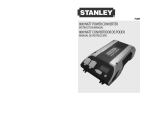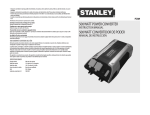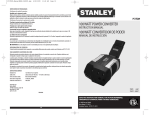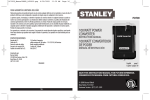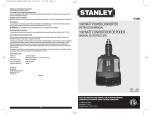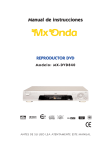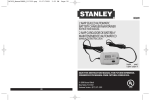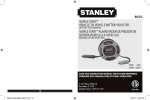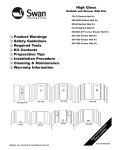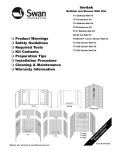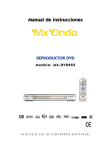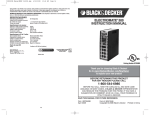Download 800 watt power converter 800 watt convertidor de poder
Transcript
PC809_ManualENSP_042809.qxp 4/28/2009 11:46 AM Page 16 PC809 800 WATT POWER CONVERTER INSTRUCTION MANUAL 800 WATT CONVERTIDOR DE PODER MANUAL DE INSTRUCCIÓN English page 3 Español pagina 9 SAVE THIS INSTUCTION MANUAL FOR FUTURE REFERENCE. CONSERVE ESTE MANUAL PARA FUTURAS CONSULTAS. © 2009 Baccus Global Boca Raton, FL 33432 Customer Service: (877) 571-2391 16 PC809_ManualENSP_042809.qxp 4/28/2009 11:46 AM Page 2 GENERAL SAFETY WARNINGS AND INSTRUCTIONS FEATURES CARACTERÍSTICAS 7 READ ALL INSTRUCTIONS WARNING: Read all instructions before operating converter. Failure to follow all instructions listed below may result in electric 8 shock, fire and/or serious injury. 9 SAFETY GUIDELINES / DEFINITIONS DANGER: Indicates an imminently hazardous situation which, if not avoided, will result in death or serious injury. WARNING: Indicates a potentially hazardous situation which, if not avoided, could result in death or serious injury. CAUTION: Indicates a potentially hazardous situation which, if not avoided, may result in minor or moderate injury. CAUTION: Used without the safety alert symbol indicates potentially hazardous situation which, if not avoided, may result in property damage. RISK OF UNSAFE OPERATION. When using tools or equipment, basic safety precautions should always be followed to reduce the risk of personal injury. Improper operation, maintenance or modification of tools or equipment could result in serious injury and property damage. There are certain applications for which tools and equipment are designed. Manufacturer strongly recommends that this product NOT be modified and/or used for any application other than for which it was designed. Read and understand all warnings and operating instructions before using any tool or equipment. 6 4 IMPORTANT SAFETY INSTRUCTIONS WARNING: This product or its power cord contains lead, a chemical known to the State of California to cause cancer and birth defect or other reproductive harm. Wash hands after handling. • Avoid dangerous environments. Don’t use converters in damp or wet locations. • Keep children away. Keep away from children. This is not a toy! • Store indoors. When not in use, converters should be stored indoors in dry, and high or locked-up places – out of reach of children. • DIsconnect the converter from the power supply when not in use. • Proper cooling is essential when operating the converter. Do not place it near a vehicle’s heat vent or in direct sunlight. • Use of accessories and attachments: The use of any accessory or attachment not recommended by manufacturer for use with this converter could be hazardous. • Stay alert. Use common sense. Do not operate converter when you are tired. • Check for damaged parts. Any part that is damaged should be properly repaired or replaced by an authorized service center unless otherwise indicated elsewhere in this instruction manual before further use. • Do not operate the converter near flammable liquids or in gaseous or explosive atmospheres. Motors in tools or appliances used with the converter may spark, and the sparks might ignite fumes. 6 1 2 SPECIFIC SAFETY INSTRUCTIONS FOR CONVERTERS 5 3 4 10 FEATURES CARACTERÍSTICAS 1. Ventilation slots 2. LCD Display 3. AC On/Off button 4 USB power port 5. Mounting brackets (total of 4, 2 in front, 2 in back) 6. Three-prong 120 volt AC outlets 7. Red (positive) cable post 8. High-speed cooling fan 9. Black (negative) cable post 10. Battery clips with cables and “O”ring connectors 1. Ranuras de ventilación 2. Pantalla del LCD 3. Botón con./desc. (on/off) de CA 4 Puerto de la energía USB 5. Consolas de montaje (total de 4, 2 en frente, adentro parte posterior 2) 6. Tomacorrientes de tres patas de CA de 120 voltios 7. Poste del cable rojo (positivo) 8. Ventilador de enfriamiento de alta velocidad 9. Poste del cable negro (negativo) 10. Clips de la batería con los cables y los conectadores del anillo de “O” 2 WARNING: TO REDUCE THE RISK OF ELECTRIC SHOCK: • Do not connect to AC distribution wiring. • Do not make any electrical connections or disconnections in areas designated as IGNITION PROTECTED. This converter is NOT approved for ignition protected areas. • Never immerse the converter in water or any other liquid, or use when wet. • Do not insert foreign objects into the converter’s outlets. WARNING: TO REDUCE THE RISK OF FIRE: • Do not operate near flammable materials, fumes or gases. • Do not expose to extreme heat or flames. CAUTION: TO REDUCE THE RISK OF INJURY OR PROPERTY DAMAGE: • Disconnect appliance plug from converter outlet before working on the appliance. • Always use the converter where there is adequate ventilation. Do not block ventilation slots. • Always turn the converter off and disconnect it from the power source when not in use. • The converter must be connected only to batteries with a nominal output voltage of 12 volts. The unit will not operate from a 6 volt battery and will sustain permanent damage if connected to a 24 volt battery. • When using this unit in a vehicle, check the vehicle owner’s manual for maximum power rating and recommended output. Do not install in engine compartment — install in a well ventilated area. • Do not use with positive ground electrical systems.* Reverse polarity connection will result in a blown fuse and may cause permanent damage to the converter and will void warranty. *The majority of modern automobiles, RVs and trucks are negative ground. • Keep in mind that this converter will not operate high wattage appliances or equipment that produce heat, such as hair dryers, microwave ovens and toasters. 3 PC809_ManualENSP_042809.qxp 4/28/2009 11:46 AM Page 4 • DO NOT OPEN THE CONVERTER — there are no user-serviceable parts inside. Opening the converter will void manufacturer’s warranty. • Do not use this converter with medical devices. It is not tested for medical applications. • Install and operate converter only as described in this Instruction Manual. POWER AND FAULT INDICATORS ON THE LCD DISPLAY Indicates that the unit is connected properly and functioning normally. SAVE THESE INSTRUCTIONS WARNING: TO REDUCE THE RISK OF INJURY OR PROPERTY DAMAGE: Follow these instructions and those published by battery manufacturer and the manufacturer of any equipment you intend to use with this unit. Review cautionary markings on these products and on engine. This indicates an input voltage too low fault condition. Refer to the following section for an explanation. INTRODUCTION Congratulations on purchasing your new converter. Read this Instruction Manual and follow the instructions carefully before using your new converter. This power converter is configured to supply continuous power in the form of two 120 volt AC outlets and a 5 volt USB charging port to run most household or electronic appliances. This indicates an input voltage too high fault condition. Refer to the following section for an explanation. HOW THIS CONVERTER WORKS This indicates a thermal fault condition. Refer to the following section for an explanation. This converter is an electronic device that converts low voltage DC (direct current) electricity from a battery to 120 volts AC (alternating current) household power. It converts power in two stages. The first stage is a DC-to-DC conversion process that raises the low voltage DC at the converter input to 145 volts DC. The second stage is a MOSFET bridge stage that converts the high voltage DC into 120 volts, 60 Hz AC. Power Converter Output Waveform The AC output waveform of this converter is known as a modified sine wave. It is a stepped waveform that has characteristics similar to the sine wave shape of utility power. This type of waveform is suitable for most AC loads, including linear and switching power supplies used in electronic equipment, transformers, and small motors. CAUTION: RECHARGEABLE DEVICES • Certain rechargeable devices are designed to be charged by plugging them directly into an AC receptacle. These devices may damage the converter or the charging circuit. • When using a rechargeable device, monitor its temperature for the initial ten minutes of use to determine if it produces excessive heat. • If excessive heat is produced, this indicates the device should not be used with this converter. • This problem does not occur with most of the battery-operated equipment. Most of these devices use a separate charger or transformer that is plugged into an AC receptacle. • The converter is capable of running most chargers and transformers. POWER SOURCE REQUIREMENTS Your converter will operate from input voltages between 11 and 15 volts DC. If the input voltage drops below 10 volts DC, the converter will shut down. This feature protects the battery from being completely discharged. The converter will also shut down if the input voltage exceeds 15.4 volts. This protects the converter against excessive input voltage. Although the converter has built-in protection against over voltage, it may still be damaged if the input voltage exceeds 15 volts. Your converter is engineered to be connected directly to standard electrical and electronic equipment in the manner described in the “Installation” section of this Instruction Manual. Do not connect the converter to household or RV AC distribution wiring. Do not connect the converter to any AC load circuit in which the neutral conductor is connected to ground (earth) or to the negative of the DC (battery) power source. Inductive loads, such as TVs and stereos, require more current to operate than resistive loads of the same wattage rating. Induction motors, as well as some TVs, may require two to six times their rated wattage to start up. Because these converters have a peak watt power rating, many such appliances and tools may be safely operated. The equipment that needs the highest starting wattage are pumps and compressors that start under load. This equipment can be safely tested. If an overload is detected, the converter will simply shut down until the overload situation is corrected. Use the front panel switch to turn off the converter, then on again to reset it. CAUTIONS • Exceeding recommended voltage limits will void manufacturer’s warranty. • NEVER try to use your converter with any 12 volt DC power source that uses a positive ground. (Most vehicles and boats use negative ground systems.) • The Power Converter must be connected only to batteries with a nominal output voltage of 12 volts. The unit will not operate from a 6 volt battery and will sustain permanent damage if connected to a 24 volt battery. • Reverse polarity connection will result in a blown fuse and may cause permanent damage to the converter. This indicates a USB fault condition, and displays when the USB load exceeds capacity. This indicates an overload or short circuit fault condition. Refer to the following section for an explanation. PROTECTIVE FEATURES The converter monitors the following conditions: Input Voltage Too Low: This condition is not harmful to the converter, but could damage the power source, so the converter will automatically shut down when input voltage drops below 10.5 ± 0.3 volts DC. Input Voltage Too High: The converter will automatically shut down when DC input voltage exceeds 15.4 ± 0.3 volts, as this can harm the unit. Thermal Shutdown Protection: The converter will automatically shut down when the unit becomes overheated. Overload/Short Circuit Protection: The converter will automatically shut down when an overload or short circuit occurs. Note: Refer to “Power and Fault Indicators on the LCD Display”for an explanation of the icons that indicate a fault condition before shutdown. CAUTION If turning the On/Off switch off, then on again does not reset the converter, DO NOT ATTEMPT TO OPEN THE CONVERTER. Opening the converter for any reason will void the warranty. The unit must be returned to manufacturer for testing and repair by professional factory technicians. RATED VERSUS ACTUAL CURRENT DRAW OF EQUIPMENT Most electrical tools, appliances, electronic devices and audio/visual equipment have labels that indicate the power consumption in amps or watts. Be sure that the power consumption of the item to be operated is below 800 watts. If the power consumption is rated in amps AC, simply multiply by the AC volts (120) to determine the wattage. Resistive loads are the easiest for the converter to run; however, it will not run larger resistive loads (such as electric stoves and heaters), which require far more wattage than the converter can deliver. Inductive loads (such as TVs and stereos) require more current to operate than do resistive loads of the same wattage rating. For safety reasons, the converter will simply shut down if it is overloaded. To restart the unit, simply unplug all devices plugged into the converter; disconnect the converter from any 12 volt DC power source; then reconnect the converter BEFORE plugging the appliance(s) back in. INSTALLATION Your converter will provide you with continuous electrical power when powered by a reliable 12 volt DC source, such as a vehicle battery or a multiple battery configuration. This manual does not describe all of the possible configurations. Mounting the Converter The converter comes equipped with mounting brackets for long-term installation. Secure the converter using screws appropriate to the mounting surface (not supplied). Use ONLY non-corrosive marine fasteners and fittings for marine installation. 4 5 PC809_ManualENSP_042809.qxp 4/28/2009 11:46 AM Page 6 CAUTION To avoid the risk of property damage, only mount the converter on a level, stable surface, assuring that all screws are tightened securely and observing all of the cautions and recommendations regarding installation found in this manual. Operating Environment For best operating results, your converter should be placed on a flat surface, such as the ground, car floor or seat, or other solid surface to help diffuse the heat that is generated. Position the converter as close to the DC power source as possible. The converter should only be operated in locations that meet the following criteria: DRY – Do not allow water and/or other liquids to come into contact with the converter. COOL – Ambient air temperature should be between 30°F (–1°C) non-condensing and 105°F (40°C). Do not place the converter on or near a heating vent or any piece of equipment that is generating heat above room temperature. Keep the converter out of direct sunlight. VENTILATED – Allow at least three inches of clearance from other objects to ensure free air circulation around the converter. Never place items on or over the converter during operation. SAFE – Do not locate converters in an area, room or compartment where explosives or flammable fumes might be present, such as engine rooms, engine compartments, and boats or small, unvented battery compartments. Marine Applications DO NOT install the converter below or near the waterline, and keep the converter away from moisture and water. The unit’s housing is moistureresistant (NOT waterproof). ONLY install the converter on a level, stable surface where it is not likely to fall or be knocked over; and is not subject to vibration. Use ONLY non-corrosive marine fasteners and fittings for installation. WARNING: TO REDUCE THE RISK OF ELECTRIC SHOCK OR PROPERTY DAMAGE In all marine applications, always observe the directions given above, as well as those listed in the Important Safety Instructions of this manual. Connecting to a Power Source Using the Supplied Battery Clips with “O” Ring Connectors Use the provided battery clips (with cables and “O”ring connectors) to connect the converter directly to the 12 volt power source as follows: 1. Check to make sure the converter’s On/Off switch has been turned off (the power/fault LED is not lit) and that no flammable fumes are present in the installation area. 2. Turn the red plastic cap (counterclockwise) on the converter’s positive (+) cable post and remove. Attach the positive “O”ring at the end of the red battery clip cable. Replace the cap and turn clockwise to secure. Do not over-tighten. 3. Turn the black plastic cap (counterclockwise) on the converter’s negative (–) cable post and remove. Attach the negative “O”ring at the end of the black battery clip cable. Replace the cap and turn clockwise to secure. Do not over-tighten. 4. Make sure that all connections between cables and terminals are secure. Direct Hardwiring to Power Source (optional connection method; hardware not included) Use #8 AWG wire if the converter-to-power source connection is 4 feet or less. For longer cable lengths, use #6 AWG wire for lengths to 10 feet. For cable lengths exceeding 10 feet from converter to battery, contact manufacturer for additional information. In either case, protect the positive (+) wire from shorts by installing a 150 amp fuse or circuit breaker close to the DC power source (battery) terminal. The cable, fuse holder and fuse (not supplied) can be purchased at an electrical supply company. PROCEDURE 1. Check to make sure the converter’s On/Off button is turned off and that no flammable fumes are present in the installation area. 2. Identify the positive (+) and negative (–) DC power source (battery) terminals. 3. Install a fuse holder or breaker close to the positive (+) terminal of the DC source (battery). 4. Connect a length of wire on one side of the fuse holder or circuit breaker. Connect the other end of the wire to the positive (+) terminal of the converter. 5. Connect a length of wire between the converter’s negative (–) terminal and the DC power source negative (–) terminal. 6. Connect a short length of wire to the other terminal of the fuse holder or circuit breaker. Mark it “positive”or “+”. 7. Connect the free end of the fuse or breaker wire to the positive (+) terminal of the DC power source (battery). 8. Insert a fuse appropriate to the converter in the fuse holder. 9. Test the converter by turning it on and plugging in a 100 watt lamp or equipment. 10. If the converter is not properly operating, then refer to the “Troubleshooting”section of this manual. CAUTIONS: TO REDUCE THE RISK OF PROPERTY DAMAGE • Loose connectors may cause overheated wires and melted insulation. • Check to make sure you have not reversed the polarity. Damage due to reversed polarity is not covered by manufacturer’s warranty. IMPORTANT CABLE INFORMATION Substantial power loss and reduced battery operating time results from converters installed with cables that are not able to supply full power. Symptoms of low battery power can result from cables that are either excessively long or an insufficient gauge. Marine installations are also subjected to vibration and stresses that exceed those of other mobile installations. Therefore, the installer/operator should be especially aware of 6 the requirements to maintain secure, tight, water-resistant electrical connections and to provide for strain relief for DC cables and appliance wiring. Cable insulation must be the appropriate type for the environment. OPERATING INSTRUCTIONS Refer to “Power and Fault Indicators on the LCD Display”for an explanation of the operating and fault icons. If a fault icon appears, refer to the “Troubleshooting”section. The USB port is ready to use whenever the converter is properly connected to a power source. To use the 120 volt AC outlets, however, the converter must be properly connect to a power source and the AC on/off button must be turned on. CAUTION: TO REDUCE THE RISK OF PROPERTY DAMAGE: Always connect the converter to the 12 volt DC power source before plugging any devices into the unit. The standard North American 120 volt AC and USB outlets allow simultaneous operation of multiple devices. Simply plug the 110/120 volt AC appliance into one of the converter’s three-prong AC outlet and/or plug the USB-powered device into the converter’s USB charging port and operate normally. Notes: Ensure that the wattage of all equipment simultaneously plugged into the converter does not exceed 800 watts continuous. The converter will not operate appliances and equipment that generate heat, such as hair dryers, electric blankets, microwave ovens and toasters. This converter’s USB Charging Port does not support data communication. It only provides 5 volts/500mA DC power to an external USB-powered device. Remember to turn the unit off and disconnect from any power source when it is not in use. CARE AND MAINTENANCE Storage 1. Ideal storage temperature range is 0-40°C (32-104°F). 2. Store and use the converter in a cool, dry place with adequate ventilation for all-around air circulation. 3. Avoid locations that are exposed to heating units, radiators, direct sunlight, or excessive humidity or dampness. TROUBLESHOOTING Common Audio/Visual Problems Buzzing Sound In Audio Systems Some inexpensive stereo systems and boom boxes make a buzzing sound when operated from the converter, because the power supply in the electronic device does not properly filter the modified sine wave produced by the converter. The only solution to this problem is to use a sound system that has a higher quality power supply. Television Interference The converter is shielded to minimize interference with TV signals. However, in some instances, some interference may still occur, particularly where TV signals are weak. Try the following corrective measures: • Place the converter as far as possible from the television, the antenna and the antenna cables. Use an extension cable, if necessary. • Readjust the orientation of the converter, the antenna cables and the TV power cord to minimize interference. • Make sure the antenna feeding the television provides an adequate (“snow free”) signal and that high quality, shielded antenna cable is used. • Do not use the converter to operate high-power appliances or tools at the same time you are using it to operate the TV. Common Power Output Problems Input voltage below 10.5 volts Recharge auto battery or check DC power supply. Equipment being operated draws too much power Reduce load to maximum 800 watts. Converter in thermal shutdown condition Allow converter to cool down. Ensure there is adequate ventilation around the unit and that the load is no more than 800 watts for continuous operation. AC output is shorted Unplug the AC appliance. Turn off the converter. Disconnect the unit from any 12 volt DC power source. Check the appliance cord. ACCESSORIES Recommended accessories for use with your tool are available from your local dealer or authorized service center. If you need assistance regarding accessories, please contact manufacturer at (877) 571-2391. WARNING: The use of any accessory not recommended for use with this appliance could be hazardous. SERVICE INFORMATION Whether you need technical advice, repair, or genuine factory replacement parts, contact the manufacturer at (877) 571-2391. 7 PC809_ManualENSP_042809.qxp 4/28/2009 11:46 AM Page 8 ONE-YEAR LIMITED WARRANTY ADVERTENCIAS E INSTRUCCIONES DE SEGURIDAD GENERALES Manufacturer warrants this product for one year against any defects in material or workmanship. The defective product will be replaced or repaired at no charge in either of two ways. The first, which will result in exchanges only, is to return the product to the retailer from whom it was purchased (provided that the store is a participating retailer). Returns should be made within the time period of the retailer’s policy for exchanges (usually 30 to 90 days after the sale). Proof of purchase may be required. Please check with the retailer for their specific return policy regarding returns that are beyond the time set for exchanges. The second option is to return the product (prepaid) to the manufacturer for repair or replacement at our option. Proof of purchase may be required. This warranty does not apply to accessories. This warranty gives you specific legal rights and you may have other rights which vary from state to state or province to province. This product is not intended for commercial use. SPECIFICATIONS Maximum power: Input voltage: Output voltage: Output waveform: USB: 800 watts continuous 12.5 volts DC 110-125 volts AC, 60Hz Modified Sine Wave 5VDC, 500mA LEA LAS INSTRUCCIONES ADVERTENCIA: Lea todas las instrucciones antes de operar el convertidor. El incumplimiento de todas las instrucciones enumeradas a continuación puede provocar una descarga eléctrica, un incendio o lesiones graves. NORMAS DE SEGURIDAD / DEFINICIONES PELIGRO: Indica una situación de peligro inminente que, si no se evita, provocará la muerte o lesiones graves. ADVERTENCIA: Indica una situación de peligro inminente que, si no se evita, provocará la muerte o lesiones graves. PRECAUCIÓN: Indica una situación de peligro potencial que, si no se evita, puede provocar lesiones leves o moderadas. PRECAUCIÓN: Utilizado sin el símbolo de alerta de seguridad indica una situación de peligro potencial que, si no se evita, puede provocar daños en la propiedad. RIESGO DE OPERACIÓN INSEGURA. Cuando se utilizan herramientas o equipos, siempre se deben respetar las precauciones de seguridad para reducir el riesgo de lesiones personales. La operación, el mantenimiento o la modificación incorrectos de herramientas o equipos pueden provocar lesiones graves y daños a la propiedad. Las herramientas y los equipos están diseñados para determinados usos. Fabricante recomienda encarecidamente que NO se modifique este producto y que NO se utilice para ningún otro uso que aquél para el que fue diseñado. Lea y comprenda todas las instrucciones operativas y las advertencias antes de utilizar cualquier herramienta o equipo. INSTRUCCIONES IMPORTANTES SOBRE SEGURIDAD ADVERTENCIA: Este producto o su cable de alimentación contiene plomo, una sustancia química reconocida por el Estado de California como Imported by Baccus Global 399 NW 2nd Avenue, Suite 150 Boca Raton, FL 33432 (877) 571-2391 RD042809 causante de cáncer, defectos de nacimiento u otros problemas reproductivos. Lávese las manos después de utilizarlo. • Evite las condiciones ambientales peligrosas. No utilice artefactos en zonas húmedas o mojadas. No utilice artefactos bajo la lluvia. • Mantenga a los niños ausentes. Guarde lejos de niños. ¡Esto no es un juguete! • Guarde los artefactos que no utilice en el interior. Cuando no los utilice, los artefactos deben guardarse en el interior en un lugar seco, alto o bajo llave, lejos del alcance de los niños. • Desconecte los aparatos. Desconecte el aparato de la fuente de energía cuando no lo utiliza. • El enfriamiento correcto es fundamental al operar el convertidor. No coloque la unidad cerca de los orificios de ventilación del vehículo ni la exponga a la luz solar directa. • Uso de suplementos y accesorios. El uso de accesorios o dispositivos no recomendados para este aparato puede resultar peligroso. • Manténgase alerta. Use el sentido común. No haga funcionar el inversor cuando está cansado. • Verifique que no haya piezas dañadas. Cualquier parte se dañe que se debe reparar o substituir correctamente por un centro de servicio autorizado a menos que se indicare contrariamente a otra parte en este manual de la instrucción antes de que sea futuro utiliza. • No opere herramientas eléctricas portátiles cerca de líquidos inflamables o en atmósferas gaseosas o explosivas. Los motores de estas herramientas normalmente chispean, y las chispas pueden encender los vapores. INSTRUCCIONES DE SEGURIDAD ESPECÍFICAS PARA LOS CONVERTIDORES ADVERTENCIA: PARA REDUCIR EL RIESGO DE DESCARGA ELÉCTRICA: • No conecte al cableado de distribución de CA. • No realice conexiones o desconexiones eléctricas en áreas designadas como PROTEGIDAS CONTRA IGNICIÓN. Esta unidad NO está aprobada para áreas protegidas contra ignición. • Nunca sumerja la unidad en el agua ni en ningún otro líquido, ni la utilice cuando esté húmeda. • No inserte los objetos extranjeros en los enchufes del convertidor. ADVERTENCIA: PARA REDUCIR EL RIESGO DE INCENDIO: • No opere cerca de materiales, vapores o gases inflamables. • No lo exponga al calor extremo o a las llamas. PRECAUCIÓN: PARA REDUCIR EL RIESGO DE LESIONES O DAÑO A LA PROPIEDAD: • Desconecte el enchufe de el aparato del enchufe del convertidor antes de trabajar en el aparato. • Siempre utilice el convertidor en lugares adecuadamente ventilados. No bloquee las ranuras de ventilación. • Apague siempre el convertidor y desconéctelo de la fuente de energía cuando es parado. • El conversor debe estar conectado solamente a baterías con un voltaje de salida nominal de 12 voltios. La unidad no funcionará si se coloca una batería de 6 voltios y ocasionará un daño permanente si se conecta a una batería de 24 voltios. • Al utilizar esta unidad en un vehículo, revise el manual del usuario del vehículo para ver el máximo rango de potencia y la salida recomendada. No lo instale en el compartimiento del motor. Instálelo en un área bien ventilada. • No lo utilice con sistemas eléctricos con positivo a tierra*. La conexión de polaridad inversa hará que un fusible se queme y puede causar un daño permanente al conversor y anulará la garantía. *La mayoría de los automóviles, vehículos recreativos y camiones modernos posee un negativo a tierra. 8 9 PC809_ManualENSP_042809.qxp 4/28/2009 11:47 AM Page 10 • Tenga en cuenta que este convertidor no funcionará con aparatos o equipos de alta potencia en vatios que produzcan calor, como secadores de cabello, hornos de microondas y tostadores. • NO ABRA EL CONVERTIDOR: no hay piezas que el usuario pueda reparar en su interior. Apertura del convertidor anulará la garantía del fabricante. • No utilice este convertidor con dispositivos médicos. No se ha comprobado su funcionamiento en aplicaciones médicas. • Instale y opere la unidad solamente como se describe en este manual de instrucciones. • Controle el desgaste de la unidad periódicamente. Vuelva al fabricante para el reemplazo de piezas gastadas o defectuosas inmediatamente. INDICADORES DE LA ENERGÍA Y DE LA AVERÍA EN LA PANTALLA DEL LCD Indica que la unidad está conectada correctamente y funcionando normalmente. CONSERVE ESTAS INSTRUCCIONES Esto indica una condición de avería demasiado baja del voltaje de entrada. Refiera a la sección siguiente para una explicación. ADVERTENCIA: PARA REDUCIR EL RIESGO DE LESIONES: Siga estas instrucciones y las publicadas por el fabricante de la batería y de cualquier equipo que tenga la intención de utilizar con esta unidad. Revise las indicaciones sobre precauciones en estos productos y en el motor. INTRODUCCIÓN Esto indica una condición de avería demasiado alta del voltaje de entrada. Refiera a la sección siguiente para una explicación. Felicitaciones por adquirir su nuevo convertidor. Lea el manual de instrucción y siga las instrucciones cuidadosamente antes de utilizar su convertidor. Este convertidor de la energía se configura suministrar energía continua bajo la forma de dos enchufes de la CA de 120 voltios y puerto de carga del USB de 5 voltios de funcionar la mayoría del hogar o de las aplicaciones electrónicas. Este indica una condición de avería termal. Refiera a la sección siguiente para una explicación. FUNCIONAMIENTO DEL CONVERTIDOR El convertidor es un dispositivo electrónico que convierte electricidad de CC (corriente continua) de bajo voltaje de una batería a energía para uso doméstico de CA (corriente alterna) de 120 voltios. El convertidor de 800 vatios convierte la energía en dos etapas. La primera etapa consiste en un proceso de conversión de CC a CC que incrementa la CC de bajo voltaje en la entrada del convertidor a CC de 145 voltios. La segunda etapa es una etapa puente MOSFET (transistor de efecto de campo semiconductor de óxido metálico) que convierte la CC de alto voltaje a CA de 120 voltios, 60 Hz. Esto indica una condición de avería del USB, y exhibiciones cuando la carga del USB excede capacidad. La forma de onda de salida del convertidor eléctrico La forma de onda de la salida de CA de este convertidor se conoce como una onda senoidal modificada. Es una forma de onda escalonada que posee características similares a la forma de onda senoidal de la electricidad. Este tipo de forma de onda es adecuado para la mayoría de las cargas de CA, incluidas las fuentes de energía por conmutación y lineales utilizadas en equipos electrónicos, transformadores y motores pequeños. PRECAUCIÓN: DISPOSITIVOS RECARGABLES • Algunos dispositivos recargables están diseñados para cargarse al ser enchufados directamente en un tomacorriente de CA. Estos dispositivos pueden dañar el convertidor o el circuito que se está cargando. • Al utilizar un dispositivo recargable, supervise la temperatura durante los primeros 10 minutos de uso para determinar si genera calor en exceso. • Si produce calor en exceso, esto indica que el dispositivo no debe utilizarse con este convertidor. • Este problema no se presenta con la mayoría de los equipos operados con batería. La mayoría de estos dispositivos utiliza un cargador o transformador por separado que está enchufado en un tomacorriente de CA. • El convertidor puede funcionar con la mayoría de los cargadores y transformadores. REQUISITOS DE LA FUENTE DE ENERGÍA Su conversor funcionará con un voltaje de entrada de entre 11 y 15 voltios de CC. El conversor se apagará si el voltaje de entrada desciende por debajo de 10 voltios de CC. Esta característica incorporada evita que la batería esté totalmente descargada. El conversor también se apagará si el voltaje de entrada excede los 15,4 voltios. Esta característica evita el voltaje de entrada excesivo en el conversor. Aunque el conversor posee protección incorporada contra voltaje en exceso, igualmente corre el riesgo de dañarse si el voltaje de entrada excede los 15 voltios. Su conversor está diseñado para conectarse directamente a equipos eléctricos y electrónicos estándar de la forma en que se describió anteriormente. No conecte el Conversor eléctrico a cableados de distribución de CA de vehículos recreativos o para uso doméstico. No conecte el conversor a cualquier circuito de carga de CA en el que el conductor neutro esté conectado a tierra o al negativo de la fuente (batería) de energía de CC. Las cargas inductivas, como televisores y estéreos, exigen más corriente para funcionar que las cargas resistivas de la misma clasificación de potencia en vatios. Los motores de inducción, y algunos televisores, pueden demandar una cantidad de vatios de dos a seis veces mayor que su capacidad nominal para funcionar. Como estos conversores tienen un rango de potencia máximo, muchos de estos aparatos y herramientas pueden operarse de manera segura. Las bombas y los compresores son equipos que exigen la potencia en vatios más alta para funcionar. Estos equipos pueden probarse de manera segura. Si se detecta una sobrecarga, los conversores simplemente se apagarán hasta que se corrija dicha situación. Utilice el interruptor del panel frontal para apagar el conversor, luego presione encender, para reiniciarlo. PRECAUCIONES • Exceder los límites de voltaje recomendados anulará la garantía del fabricante. • NUNCA intente usar su conversor con cualquier fuente de energía de CC de 12 voltios que utilice positivo a tierra. (La mayoría de los vehículos y embarcaciones utilizan sistemas con negativo a tierra). • El Conversor eléctrico debe estar conectado solamente a baterías con un voltaje de salida nominal de 12 voltios. La unidad no funcionará si se coloca una batería de 6 voltios y ocasionará un daño permanente si se conecta a una batería de 24 voltios. • La conexión de polaridad inversa hará que un fusible se queme y puede causar un daño permanente al conversor. 10 Esto indica una condición de la sobrecarga o de avería del cortocircuito. Refiera a la sección siguiente para una explicación. CARACTERÍSTICAS DE PROTECCIÓN El convertidor supervisa las siguientes condiciones: Voltaje de entrada demasiado bajo: Este estado no es perjudicial para el convertidor, pero puede dañar la fuente de energía, de modo que el convertidor se apagará automáticamente cuando el voltaje de entrada disminuya a una CD de 10,5 ± 0,3 voltios. Voltaje de entrada demasiado alto: El convertidor se apagará automáticamente cuando el voltaje de entrada de CC exceda los 15,4 ± 0,3 voltios, ya que esto puede dañar la unidad. Protección de apagado térmico: El convertidor se apagará automáticamente cuando la unidad se sobrecaliente. Protección contra cortocircuitos o sobrecargas: El convertidor se apagará automáticamente en presencia de un cortocircuito o sobrecargas. Notas: Refiera a los “Indicadores de la energía y de la avería en la pantalla del LCD”para una explicación de los iconos que indican una condición de avería antes de parada. PRECAUCIÓN Si apaga el interruptor con./desc. (on/off) entonces encendido no reajusta otra vez el inversor, NO INTENTE ABRIR EL CONVERSOR. La apertura del inversor por cualquier razón anulará la garantía. La unidad se debe volver al fabricante para la prueba y la reparación por los técnicos profesionales de la fábrica. CONSUMO DE CORRIENTE REAL VERSUS CALIFICADO DEL EQUIPO La mayoría de las herramientas eléctricas, los aparatos, los dispositivos electrónicos y los equipos visuales/de audio poseen etiquetas que indican el consumo de energía en amperios o vatios. Asegúrese de que el consumo de energía del artículo que desee operar sea menor a 800 vatios. Si el consumo de energía se clasifica en CA de amperios, simplemente multiplique por los voltios de CA (120) para determinar la vatiaje. El convertidor puede transportar las cargas resistivas con más facilidad, no obstante, no aceptará cargas resistivas más grandes (como estufas y calentadores eléctricos) que requieran mucha más potencia en vatios de la que el convertidor puede suministrar. Las cargas inductivas (como televisores y estéreos) requieren más corriente para funcionar que las cargas resistivas de la misma clasificación de potencia en vatios. Por razones de la seguridad, el convertidor cerrará simplemente si se sobrecarga. Para recomenzar la unidad, desenchufe simplemente todos los dispositivos tapados en el convertidor; desconecte el convertidor de cualquier fuente de la CC de 12 voltios; entonces vuelva a conectar el convertidor ANTES de tapar las aplicaciones detrás adentro. INSTALACIÓN Su conversor proveerá de usted corriente eléctrica continua cuando es accionado por una fuente confiable de la CC de 12 voltios, tal como una batería del vehículo o una configuración múltiple de la batería. Este manual no describe todas las configuraciones posibles. 11 PC809_ManualENSP_042809.qxp 4/28/2009 11:47 AM Page 12 Montaje del convertidor El convertidor viene equipado de las consolas de montaje para la instalación de largo plazo. Asegure el convertidor usando los tornillos apropiados a la superficie de montaje (no suministrada). PRECAUCIÓN Para evitar el riesgo de daños materiales, monte solamente el convertidor en una superficie llana, estable, asegurando que todos los tornillos están apretados con seguridad y observando todas las precauciones y recomendaciones con respecto a la instalación encontrada en este manual. Sugerencias de operación Para obtener los mejores resultados de explotación, el conversor debe ser colocado sobre una superficie plana, como el terreno, piso o coche asiento, o de otra superficie sólida de que ayuden a disipar el calor que se genera. Coloque el conversor lo más cerca posible de la fuente de alimentación CC como sea posible. El conversor se debe funcionar solamente en las localizaciones que cumplen los criterios siguientes: SECOS — No permita que el agua u otros líquidos entren en contacto con el conversor. FRESCOS — La temperatura ambiente debe estar entre 10 y 20 °C (50 y 68 °F). Mantenga el conversor lejos de la luz solar directa siempre que sea posible. BIEN VENTILADOS — Mantenga el área que rodea el conversor limpia para garantizar la libre circulación de aire alrededor de la unidad. No coloque artículos en o sobre el conversor durante su funcionamiento. La unidad se apagará si la temperatura interna se eleva demasiado. El conversor se reiniciará automáticamente después de enfriarse. SEGUROS — No utilice el conversor cerca de materiales inflamables o en lugares donde se puedan acumular vapores o gases inflamables. Éste es un aparato eléctrico que puede generar chispas durante breves períodos si se establecen conexiones eléctricas o éstas se rompen. Aplicaciones marinas NO instale el conversor debajo o cerca de la línea de flotación, y mantenga el conversor alejado de la humedad y el agua. La cubierta de la unidad es humedad-resistente (NO resistente de agua). Instale SOLAMENTE el convertidor en una superficie llana, estable donde no está probable caer o ser golpeado; y no está conforme a la vibración. Utilice SOLAMENTE los sujetadores y las guarniciones marinas anticorrosivos para la instalación. ADVERTENCIA: PARA REDUCIR EL RIESGO DE DESCARGA ELÉCTRICA O DAÑO A LA PROPIEDAD En todos los usos marinas, observe siempre las direcciones dadas arriba, así como ésas enumeradas en las instrucciones de seguridad importantes de este manual. Conexión a una fuente de energía utilizando los clips de la batería con los conectadores del anillo de “O” 9. Pruebe el conversor encendiéndolo y enchufándolo en una lámpara o equipo de 100 vatios. 10. Si el conversor no funciona correctamente, consulte la sección “Guía de solución de problemas”de este manual. PRECAUCIONES: PARA REDUCIR EL RIESGO DE DAÑO A LA PROPIEDAD • Los conectores sueltos pueden hacer que los cables se sobrecalienten y que el aislamiento se derrita. • Compruebe para asegurarse de que no ha invertido la polaridad. Los daños ocasionados por polaridad inversa no están cubiertos por nuestra garantía. INFORMACIÓN IMPORTANTE SOBRE LOS CABLES La pérdida considerable de potencia y el menor tiempo de operación de la batería se debe a conversores instalados con cables que no pueden suministrar una potencia plena. Los síntomas de potencia baja de la batería pueden deberse a que los cables son excesivamente largos o a un calibre insuficiente. Las instalaciones marinas también están sujetas a la vibración y las tensiones que superan a aquellas de las demás instalaciones móviles. Por lo tanto, el instalador/operador debe conocer, especialmente, los requisitos para mantener seguras, tensas e impermeables las conexiones eléctricas y proporcionar alivio de tensión para los cables de CC y el cableado del aparato. El aislamiento del cable debe ser del tipo adecuado para el ambiente. INSTRUCCIONES DE OPERACIÓN Refiera a los “Indicadores de la energía y de la avería en la exhibición del LCD”para una explicación del funcionamiento y de los iconos de la avería. Si aparece un icono de la avería, consulte la sección "Detección de problemas" de este Manual de instrucciones. El puerto del USB es listo para utilizar siempre que el convertidor esté conectado correctamente con una fuente de energía. Para utilizar los enchufes de la CA de 120 voltios, sin embargo, el convertidor debe estar correctamente conecta con una fuente de energía y el botón con./desc. (on/off) de la CA se debe girar. PRECAUCIÓN: PARA REDUCIR EL RIESGO DE DAÑO A LA PROPIEDAD: Siempre conecte el convertidor a la fuente de energía de cc de 12 voltios antes de conectar cualquier dispositivo al convertidor. Los tomacorrientes estadounidenses estándar de CA de 120 voltios y los puertos USB permiten al usuario operar varios dispositivos simultáneamente. Simplemente tape la aplicación de la CA de 110/120 voltio en el enchufe de la CA del tres-diente del inversor y/o tape el dispositivo USB-accionado en el puerto de carga del USB del inversor y funcione normalmente. Nota: Asegúrese de que la potencia en vatios de todos los equipos enchufados simultáneamente en el convertidor no supere los 800 vatios continuos. El convertidor no servirá para aparatos y equipos que generen calor, como secadores de cabello, mantas térmicas, hornos de microondas y tostadores. El puerto de carga USB del convertidor no admite comunicación de datos. Sólo proporciona energía de CC de 5 voltios/500 mA a un dispositivo eléctrico USB externo. Recuerde desconectar la unidad de cualquier fuente de energía cuando no es adentro uso. Utilice los clips de batería proporcionados (con los conectadores de los cables y del anillo de “O”) para conectar el convertidor directamente con la fuente de energía de 12 voltios como sigue: 1. Compruebe para cerciorarse de que se haya extraído el botón de la energía del convertidor (el indicador LED de potencia y fallas no se enciende) y de que no haya vapores inflamables en el área de instalación. 2. Dé vuelta al casquillo plástico rojo en el poste positivo (+) del cable del convertidor a la izquierda y quítelo. Ate el anillo positivo de “O”en el final del rojo cable del clips de la batería. Substituya el casquillo y dé vuelta a la derecha para asegurar. No apriete demasiado. 3. Dé vuelta al casquillo plástico negro en el poste negativo del cable del convertidor a la izquierda y quítelo. Ate el anillo negativo (–) de “O”en el final del negro cable del clips de la batería. Substituya el casquillo y dé vuelta a la derecha para asegurar. No apriete demasiado. 4. Asegúrese de que todas las conexiones entre las pinzas de la batería y los terminales sean firmes. CUIDADO Y MANTENIMIENTO Cableado directo a la fuente de energía (método opcional de la conexión; hardware no incluido) Zumbidos en los sistemas de audio Algunos sistemas estéreos y estéreos económicos generan zumbidos cuando se los pone en funcionamiento desde el convertidor ya que la fuente de energía en el dispositivo electrónico no filtra correctamente la onda senoidal modificada producida por el convertidor. La única solución a este problema es utilizar un sistema de sonido que posea una fuente de energía de calidad superior. Interferencia con el televisor El onvertidor está protegido a fin de reducir al mínimo la interferencia con las señales de televisión. Sin embargo, en determinadas situaciones, es posible que aún haya alguna interferencia, particularmente con señales de televisión débiles. Intente las siguientes medidas correctivas: • Coloque el convertidor lo más lejos posible de la televisión, de la antena y de los cables de la antena. Utilice un cable de extensión, en caso de necesidad. • Reajuste la orientación del convertidor, de los cables de la antena y del cable eléctrico de la TV para reducir al mínimo interferencia. • Cerciórese de que la antena que alimenta la televisión proporcione (“nieve libre ") una señal adecuada y esa alta calidad, cable blindado de la antena está utilizada. • No utilice el convertidor para funcionar aplicaciones de alta potencia o las herramientas al mismo tiempo usted lo está utilizando para funcionar la TV. Utilice el alambre del AWG #8 si el convertidor a la conexión de la fuente de energía es 4 pies o menos. Para longitudes de cable más largas, utilice el alambre del AWG #6 para las longitudes a 10 pies. Para las longitudes de cable que exceden 10 pies del convertidor a la batería, consulte con el fabricante para la información adicional. En cualquier caso, proteja (+) el alambre positivo contra cortocircuitos instalando un fusible o el disyuntor de 150 amperios cerca del terminal de la fuente de CC (batería). El cable, el sostenedor del fusible y el fusible (no suministrados) se pueden comprar en una compañía de la fuente eléctrica. PROCEDIMIENTO 1. Compruebe para cerciorarse de que el botón con./desc. del convertidor está apagado y que no hay humos inflamables presentes en el área de la instalación. 2. Identifique los terminales positivo (+) y negativo (–) (batería) de la fuente de energía de CC. 3. Instale un soporte para fusibles o interruptor cerca del terminal POSITIVO (+) de la fuente de energía (batería) de CC. 4. Conecte una prolongación de cable en un lado del soporte del fusible o del interruptor automático. Conecte el otro extremo del cable al terminal positivo (+) del conversor. 5. Conecte una prolongación del cable entre el terminal negativo (–) del conversor y el terminal negativo (–) de la fuente de energía de CC. 6. Conecte una prolongación corta del cable al otro terminal del soporte del fusible o al interruptor automático. Márquelo como “positivo”o “+”. 7. Conecte el extremo libre del fusible o del cable del interruptor al terminal positivo (+) de la fuente de energía (batería) de CC. 8. Inserte un fusible adecuado al conversor en el soporte del fusible. 12 Almacenamiento 1. La temperatura ideal de almacenamiento varía entre 0 °C y 40 °C (32 °F y 104 °F). 2. Almacene y use el convertidor en un lugar fresco y seco y con ventilación adecuada en los alrededores. 3. Evite los lugares expuestos a unidades de calefacción, radiadores, luz solar directa o humedad en exceso. DETECCIÓN DE PROBLEMAS Problemas visuales/de audio frecuentes Problemas frecuentes de potencia de salida El voltaje de entrada está por debajo de 10,5 voltios Recargue la batería auto o compruebe la fuente de CC. 13 PC809_ManualENSP_042809.qxp 4/28/2009 11:47 AM Page 14 El equipo que se opera genera mucha energía Reduzca la carga a un máximo de 800 vatios. El convertidor está en la condición de apagado térmico Espere que el convertidor se enfríe. Asegúrese de que haya una ventilación adecuada alrededor de la unidad y que la carga no sea mayor a 800 vatios para un funcionamiento continuo. La salida de CA está en cortocircuito Desenchufe la aplicación de la CA. Apague el convertidor. Desconecte la unidad de cualquier fuente de la potencia CC de 12 voltios. Compruebe la cuerda de la aplicación. ACCESORIOS Los accesorios que se recomiendan para la herramienta están disponibles en su distribuidor local o en el centro de mantenimiento autorizado. Si necesita asistencia en relación con los accesorios, por favor contacto fabricante en (877) 571-2391. ADVERTENCIA: El uso de cualquier accesorio no recomendado para el uso con esta aplicación podía ser peligroso. INFORMACIÓN DE SERVICIO Si usted necesita asesoramiento técnico, reparación, o una verdadera fábrica piezas de recambio, contacto con el fabricante en (877) 571-2391. UNA GARANTÍA LIMITADA DEL AÑO Fabricante garantiza este producto durante un año contra cualquier defectos en los materiales o mano de obra. El producto defectuoso será reemplazado o reparado en ningún cargo en cualquiera de dos maneras. La primera opción, el reemplazo, es devolver el producto al comercio donde se lo adquirió (siempre y cuando se trate de un comercio participante). Las devoluciones deben realizarse conforme a la política de devolución del comercio (generalmente, entre 30 y 90 días posteriores a la venta). Prueba de compra puede ser necesaria. Consulte en el comercio acerca de la política especial sobre devoluciones una vez excedido el plazo establecido. La segunda opción es devolver el producto (pagados) al fabricante de reparación o sustitución en nuestra opción. Prueba de compra puede ser necesaria. Esta garantía no se extiende a los accesorios. Esta garantía le concede derechos legales específicos; usted puede tener otros derechos que pueden variar según el estado o la provincia. Este producto no está diseñado para uso comercial. ESPECIFICACIONES Maximum power: Voltaje de entrada: Voltaje de la salida: Forma de onda de la salida: USB: 800 watts continuous 12.5 voltios de CC 110-125 voltios de CA, 60Hz Onda de seno modificada 5VCC, 500mA Importados por Baccus Global 399 NW 2nd Avenue, Suite 150 Boca Raton, FL 33432 (877) 571-2391 RD042809 14 15








